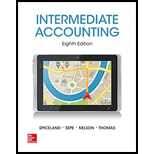
Concept explainers
1.
Periodic Inventory System: It is a system in which the inventory is updated in the accounting records on a periodic basis such as at the end of each month, quarter or year. In other words, it is an accounting method which is used to determine the amount of inventory at the end of each accounting period.
Specific identification method (SI): Specific identification method can be said as identifying the items precisely which are being sold and those which are being stored as closing inventory. The companies are required to keep perfect records of the original cost of each and every individual items of the inventory.
First-in-First-Out (FIFO): In First-in-First-Out method, the cost of initial purchased items are sold first. The value of the ending inventory consists the recent purchased items.
Last-In, First-Out (LIFO): In Last-in-First-Out method, the cost of last purchased items are sold first. The value of the closing stock consists the initial purchased items.
Weighted-average cost method (WA): In Weighted-average Method the cost of inventory is priced at the average rate of the goods available for sale.
To Calculate: The ending inventory and cost of goods sold using the specific identification method.
1.
Explanation of Solution
Compute the goods available for sales.
| Calculation of Goods Available for Sales | ||
| Details | Car ID | Cost ($) |
| Beginning balance | 203 | 60,000 |
| 207 | 60,000 | |
| 210 | 63,000 | |
| Total Beginning Balance | 183,000 | |
| Purchases | 211 | 63,000 |
| 212 | 63,000 | |
| 213 | 64,500 | |
| 214 | 66,000 | |
| 215 | 69,000 | |
| 216 | 70,500 | |
| 217 | 72,000 | |
| 218 | 72,300 | |
| 219 | 75,000 | |
| Goods Available For Sale | 798,300 | |
Table (1)
Calculate the ending inventory using specific identification method.
| Calculation of Ending Inventory | ||
| Details | Car ID | Cost ($) |
| Car Not Sold | 213 | 64,500 |
| Car Not Sold | 216 | 70,500 |
| Car Not Sold | 219 | 75,000 |
| Ending Inventory | 210,000 | |
Table (2)
Therefore, the cost of ending inventory using specific identification methodis$210,000.
Calculate the cost of goods soldusing specific identification method.
| Cost of Goods Sold | |
| Details | Cost ($) |
| Goods Available For Sales | 798,300 |
| Less: Ending Inventory | (210,000) |
| Cost of Goods Sold | 588,300 |
Table (3)
Therefore, the cost of goods sold using specific identification method is$588,300.
2.
To Calculate: The ending inventory and cost of goods sold using FIFO method.
2.
Explanation of Solution
Calculate the cost of ending inventory.
| Calculation of Ending Inventory | |
| Details | Cost ($) |
| Car ID | |
| 219 | 75,000 |
| 218 | 72,300 |
| 217 | 72,000 |
| Ending Inventory | 219,300 |
Table (4)
Therefore, the cost of ending inventory using FIFO is $219,300.
Calculate the cost of goods sold.
| Cost of Goods Sold | |
| Details | Cost ($) |
| Goods Available for Sales | 798,300 |
| Less: Ending Inventory | (219,300) |
| Cost of Goods Sold | 579,000 |
Table (5)
Therefore, the cost of goods sold using FIFO method is$579,000.
3.
To Calculate: The ending inventory and cost of goods sold using LIFO method.
3.
Explanation of Solution
Calculate the ending inventory.
| Calculation of Ending Inventory | |
| Details | Cost ($) |
| Car ID | |
| 203 | 60,000 |
| 207 | 60,000 |
| 210 | 63,000 |
| Ending Inventory | 183,000 |
Table (6)
Therefore, the cost of ending inventory using LIFO method is$183,000.
Calculate the cost of goods sold.
| Cost of Goods Sold | |
| Details | Cost ($) |
| Goods Available for Sales | 798,300 |
| Less: Ending Inventory | (183,000) |
| Cost of Goods Sold | 615,300 |
Table (7)
Therefore, the cost of goods sold using LIFO method is$615,300.
4.
To Calculate: The ending inventory and cost of goods sold using weighted-average method.
4.
Explanation of Solution
Calculate the amount of ending inventory.
Working Note:
Calculate the weighted-average cost.
Therefore, the cost of ending inventory usingweighted-average-cost method is$199,575.
Calculate the cost of goods sold.
| Cost of Goods Sold | |
| Details | Cost ($) |
| Goods Available for Sales | 798,300 |
| Less: Ending Inventory | (199,575) |
| Cost of Goods Sold | 598,725 |
Table (8)
Therefore, the cost of goods sold usingweighted-average-cost method is$598,725.
Want to see more full solutions like this?
Chapter 8 Solutions
INTERMEDIATE ACCOUNTING W/CONNECT PLUS

 AccountingAccountingISBN:9781337272094Author:WARREN, Carl S., Reeve, James M., Duchac, Jonathan E.Publisher:Cengage Learning,
AccountingAccountingISBN:9781337272094Author:WARREN, Carl S., Reeve, James M., Duchac, Jonathan E.Publisher:Cengage Learning, Accounting Information SystemsAccountingISBN:9781337619202Author:Hall, James A.Publisher:Cengage Learning,
Accounting Information SystemsAccountingISBN:9781337619202Author:Hall, James A.Publisher:Cengage Learning, Horngren's Cost Accounting: A Managerial Emphasis...AccountingISBN:9780134475585Author:Srikant M. Datar, Madhav V. RajanPublisher:PEARSON
Horngren's Cost Accounting: A Managerial Emphasis...AccountingISBN:9780134475585Author:Srikant M. Datar, Madhav V. RajanPublisher:PEARSON Intermediate AccountingAccountingISBN:9781259722660Author:J. David Spiceland, Mark W. Nelson, Wayne M ThomasPublisher:McGraw-Hill Education
Intermediate AccountingAccountingISBN:9781259722660Author:J. David Spiceland, Mark W. Nelson, Wayne M ThomasPublisher:McGraw-Hill Education Financial and Managerial AccountingAccountingISBN:9781259726705Author:John J Wild, Ken W. Shaw, Barbara Chiappetta Fundamental Accounting PrinciplesPublisher:McGraw-Hill Education
Financial and Managerial AccountingAccountingISBN:9781259726705Author:John J Wild, Ken W. Shaw, Barbara Chiappetta Fundamental Accounting PrinciplesPublisher:McGraw-Hill Education





